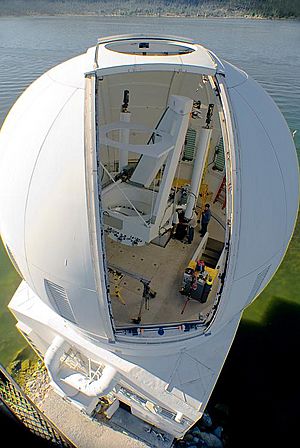Big Bear Solar Observatory facts for kids
The Big Bear Solar Observatory (BBSO) is a special place in the United States where scientists study the Sun. It's run by the New Jersey Institute of Technology (NJIT). BBSO has a very powerful telescope called the Goode Solar Telescope (GST). This telescope helps scientists see amazing details on the Sun. They also use other telescopes to watch the Sun all the time. Everything at BBSO is designed to help us learn more about our star, the Sun!
Contents
Where is the Big Bear Solar Observatory?
The Big Bear Solar Observatory is located in California, USA. It sits right on the north side of Big Bear Lake in the San Bernardino Mountains. This spot is about 120 kilometers (75 miles) east of downtown Los Angeles.
The location at Big Bear Lake is perfect for studying the Sun. The lake helps keep the air clear and steady. This means the telescopes get very clear pictures. The cool water reduces air wobbles that can blur images. The observatory building is actually built over the open waters of the lake. This helps keep the air around the building cool and steady too.
History of the Observatory
The California Institute of Technology (Caltech) built the observatory in 1969. Professor Harold Zirin led this project. In 1995, Caltech decided to let another group take over the observatory.
In 1997, the New Jersey Institute of Technology (NJIT) agreed to run BBSO. NJIT now leases the land and buildings from Caltech until 2048. The instruments and funding were also transferred to NJIT.
After this change, Professor Philip R. Goode from NJIT became the director. Today, Professor Wenda Cao is the director of BBSO. The observatory gets money from groups like NASA, the National Science Foundation, and the United States Air Force.
What Telescopes Does BBSO Use?
When NJIT took over in 1997, BBSO had smaller telescopes. But to see tiny details on the Sun, a much bigger telescope was needed. Scientists wanted to see features as small as 100 kilometers (62 miles) on the Sun's surface.
The Goode Solar Telescope (GST)
The main telescope at BBSO is the Goode Solar Telescope (GST). It's a very large telescope, about 1.6 meters (5.2 feet) wide. It's special because it's an "off-axis" telescope. This means light enters it without anything blocking the view. This helps it get super clear images.
The GST uses something called "adaptive optics" (AO). This technology helps correct the blurring caused by Earth's atmosphere. Think of it like special glasses for the telescope! AO makes the images much sharper. The GST was the first solar telescope in the United States to use this advanced technology.
Building the GST
Work on the GST started in 2005. It saw its "first light" (meaning it collected its first light from the Sun) in January 2009. By 2010, it was taking clear pictures using adaptive optics. In 2016, it started using an even more advanced AO system called MCAO. This system helps correct a wider area of the sky.
The GST can see features on the Sun that are less than 50 kilometers (31 miles) across! In July 2017, the telescope was named the Goode Solar Telescope. This honored Professor Philip R. Goode.
Other Telescopes at BBSO
BBSO also has other important telescopes. One is the 10-centimeter (4-inch) Full Disk H-alpha (FDHA) Patrol Telescope. It's in a smaller building called the Ash Dome. This telescope watches the entire Sun. It helps scientists see changes happening across the Sun's whole surface.
The observatory also hosts a station for the Global Oscillation Network Group. This group studies how the Sun vibrates, like a giant bell. This helps scientists understand what's happening deep inside the Sun. This station started working in 1995.



